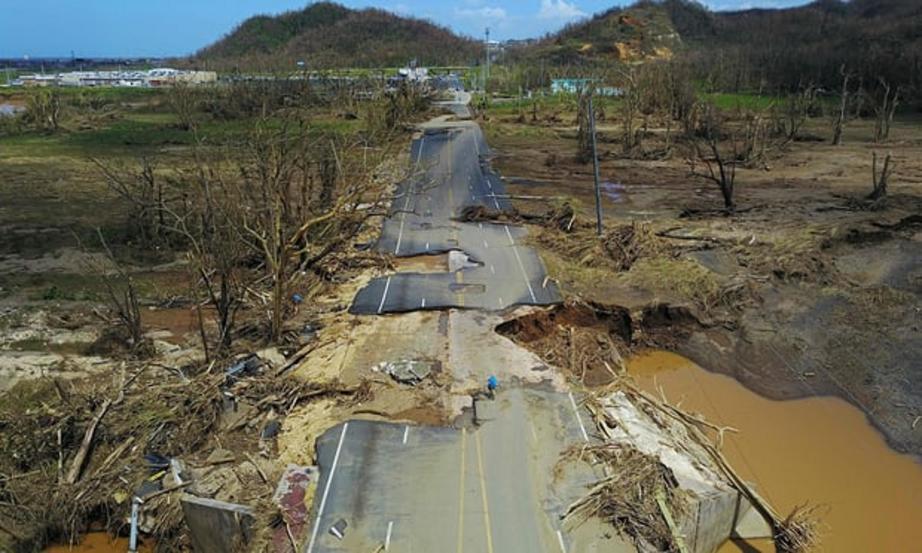Many Puerto Ricans desperate to return home to island reeling from disaster
As Puerto Rico came into view below, passengers on the JetBlue aid flight from New York fell silent as the scale of the devastation wrought by Hurricane Maria became apparent: the usually verdant mountains were brown and barren, and the bright blue water offshore was dotted with large aid ships.
A member of the flight crew addressed the passengers: “I understand what you’re feeling might be overwhelming, but Puerto Ricans are resilient.”
Before the plane touched town, that same crew member said “Puerto Rico se levanta” – Puerto Rico rises up. His voice broke. The passengers clapped, cried and whistled.
The flight carried emergency responders and journalists – but also ordinary Puerto Ricans, desperate to return home to an island still reeling from the disaster.
Even though Puerto Rico is now largely without electricity, running water is a luxury and mobile phone reception is no longer taken for granted, demand for plane tickets is high.
San Juan international airport remains crowded with stranded travelers desperate to leave the territory, but many others are heading in the opposite direction. Some returnees want to track down relatives they have not heard from since before the storm – others simply want to return home.
Hector Orellana said he would preferred to have been in Puerto Rico when the hurricane struck. At least, he said, he would have known if his parents were alive and safe.
Instead, he returned from a conference in New York on Sunday morning, carrying some canned food, water and a rough plan to get to the eastern San Lorenzo municipality – which is almost impossible to reach because of a bridge collapse – and find his parents.
“I don’t know how, but I’m going to get to my house,” he said. “I just want to get there.”
San Juan’s Luis Muñoz Marin airport is struggling. Most flights this weekend were cancelled, even though the weather was safe again. At least one flight had to turn back because it lost communication with the airport control tower.
Also onboard the was Javier Nieves, a Puerto Rican who has lived in New York for 12 years. He flew in to search for his in-laws and a nephew in the municipality of Vega Baja, where floods reached more than 10ft. The mayor, Marcos Cruz Molina, said between 2,000 and 2,500 people, including himself, lost their homes. Like most of the island, Vega Baja is almost completely without communication.
Though Nieves’s priority was finding his family, he had also taken on the role of communications officer for hundreds with loved ones in the municipality.
Governor Ricardo Rosselló said on Sunday officials still had not had communication with nine of 78 municipalities.
Puerto Ricans have used the Zello walkie-talkie app to find information on missing people, through channels specific to municipalities. Nieves told the Vega Baja channel he would report back with as much information as possible.
“Even if I park the car in the street and walk in – I’m gonna get there,” Nieves said. “I’ve lived there all my life. Puerto Ricans know how to make it work.”
There has been an outpouring of aid and support but the magnitude of the destruction, better understood each day, is overwhelming. Those tasked with disaster response must also contend with the island’s $73bn debt crisis.
“The devastation in Puerto Rico has set us back nearly 20 to 30 years,” Puerto Rico’s nonvoting representative in the US congress, Jenniffer Gonzalez, told the Associated Press. “I can’t deny that the Puerto Rico of now is different from that of a week ago. The destruction of properties, of flattened structures, of families without homes, of debris everywhere.”
This is why people are also trying desperately to leave. On Sunday morning, dozens sat waiting in the airport, which does not have functioning escalators, elevators or air conditioning. Many waved paper or cardboard, trying to stay cool. By Sunday night, the only scheduled flight out had been canceled. Only aid flights had departed. Hundreds camped out, desperate for a flight.
“I would leave if I had money,” said Harry Cuevas, a tour guide who lived through Puerto Rico’s last two major hurricanes – Hugo in 1989, George in 1998 – but said they did not prepare him for the 12 hours he spent with his wife, daughters and dogs in the bathroom of their San Juan apartment, wondering if the island would survive.
“With the wind, I felt it was so strong, I thought everything was going to be destroyed,” he said.
His water is running, but his refrigerator is no longer cold because of the lack of electricity. He can’t do his job because travel is blocked by floods and debris. He also needs gas, for which people wait hours because it is needed to run generators.
Cuevas considered the recovery to come. “Now comes the bad part,” he said.

